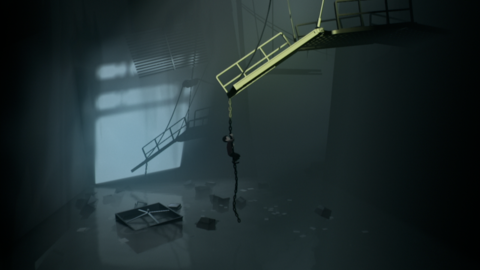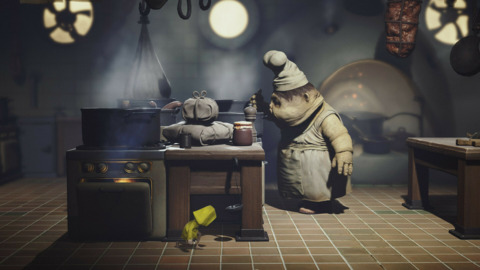Inside Little Nightmares
By Humanity 3 Comments

Back in 2010 Playdead released Limbo, a highly stylized sidescrolling platformer with a bleak atmosphere and a striking black and white presentation. It was part of the Xbox 360 Summer of Arcade rollout and something that we haven't seen before - a smaller indie title with great production values, a unique hook and an appropriate price tag to go along with the mix. Six years later Playdead would follow up Limbo with their bizarre new nightmare adventure "Inside" following the studios familiar motifs of small children traversing often oppugnant environments, solving puzzles and wading through a general miasma of ambiguity. Inside ditched the monochromatic presentation but it still remained purposefully desaturated, simplistic in geometry and relied heavily on shadow and light to create atmosphere in place of detailed textures. Inside was bizarre, at times unsettling and a great mix of horror and mystery with a twist ending that no one would have guessed would result in a collectors item created by the folks at RealDoll. I was a huge fan of Inside because of its look and at times head scratching puzzles. From simple box pushing challenges to herding crowds of "zombies" with a mind control helmet, the game ran the gamut on how much mileage you can get out of a sidescrolling 2D platformer.

While waiting for the next adventure from Playdead, there came the release of Little Nightmares - another highly stylized 2D puzzle platformer featuring little kids trying to escape the left side of the screen in a mildly horror motif. Originally titled "Hunger" the game was developed by a relatively small Swedish outfit Tarsier Studios. In many ways I think it's the perfect spiritual successor to both Inside and Limbo while simultaneously carving out it’s very own niche path in this new nightmare-child-endangerement genre. In stark contrast to Playdeads titles, Little Nightmares is highly detailed and rather colorful when it needs to be in order to accent important elements of the wonderfully unsettling backdrops. You are still a small child running from left to right and solving puzzles along the way, but Little Nightmares excels in creating a twisted, dreamlike atmosphere that is unsettling but not gruesome. The surroundings you traverse are distorted and warped, towering over your mouse sized character. Seemingly normal rooms will open up into cavernous interiors that stretch vertically in improbable ways. It all makes for a fantastically morbid atmosphere as you begin to encounter the more deranged elements of the world. Child sized cages that pile several floors high eventually lead to conveyor belts moving across the ceilings with ominous looking burlap sacks dangling off their hooks. Later on as you ride one such belt to safety from a rather terrifying encounter you end up dropping down onto a mountain of discarded little shoes, revealing what happened to all those sacks from earlier on. While the game doesn’t ever produce direct narration, the environmental storytelling is equal parts unnerving as it is aesthetically fascinating. This macabre motif repeats throughout the game as you enter each chapter and discover what nightmare entity roams it's halls.

How Light Nightmares diverges quite significantly from Inside is where each game places emphasis within its gameplay. Playdead’s titles are very cerebral ordeals that require quite a bit of ingenuity to move past their more challenging puzzles but give you plenty of time to figure it out. There are few encounters with enemies and when they do happen they’re short but tense sprints. In comparison Little Nightmares offers less head scratching but a lot more running, seemingly taking the form of one long nightmare marathon instead. You are never truly challenged by the “what” but are rather tasked with perfectly executing on the “how”. Nearly every area features an overseer of sorts that your little raincoat wearing heroine must elude. There is little room for improvisation in these encounters and quite often initially hair raising scenarios can become tedious runs of trial and error as you get caught time and time again because you ran the wrong way. This is my least favorite part of Little Nightmares and it unfortunately comprises much of the gameplay. Inside would present you with a room and allow you to sit there and puzzle it out. Things generally moved along invisible rails and solutions clicked into place in a definite manner. Little Nightmares not only doesn’t feature elaborately conceived puzzles, but the few times you are asked to do something more involved than simply hiding or sneaking by, the ability to move freely within the level instead of being glued to a specific plane presents a whole host of unintentional obstacles. Jumping to a hanging platform can become frustratingly difficult when you can’t judge your angle of approach. When traversing long skinny pipes the game doesn’t center you and it’s very possible to fall off the side as the camera pans out for a cinematic shot and you stop paying attention to your little avatar. To cap things off some of the earlier checkpoints are unnecessarily spread apart forcing you to redo mundane aspects of the puzzle just to get back to that one jumping sequence you missed up.
All that said when you’re not cowering in a corner the movement does have a wonderfully tactile feeling to it. Your primary action is a grabbing motion mapped to the right trigger. Climbing ladders, grabbing switches, carrying oversized keys - all of this requires you to hold the grab button and it goes a long way in accenting the feeling of physically when performing an action in-game. Objects carry some semblance of physics to them which makes hanging off a garbage chute to see it slowly creak open feel a lot more satisfying than if it were a simple button press. The disproportionate world makes for a perfect playground and I do wish there were more sections where you could interact with it without a giant monster constantly on your heels.
That said.. as iffy as these “combat encounters” can get there is something to be said for how they also help to keep the action moving forward. You’re never stuck on any one problem too long and the strength of the game lies in experiencing it’s bespoke, nightmare environments. I remember getting extremely frustrated at times with Inside because a puzzle was keeping me from being able to move on and my brain simply wasn’t clicking with the solution. There is also a delightfully morbid sense of satisfaction when you inevitably turn the tables on your pursuer. The story is as ambiguous as it can get but regardless of how much you gleamed of it along the way the last chapter has a satisfying finale that thankfully doesn’t involve a rolling ball of flesh. Complimented by a fantastic soundtrack, Little Nightmares to me was a great visual experience that clocking in around 3 hours was the perfect bitesize acid trip that didn’t outstay its welcome. The recently released sequel is much longer but offers a similar array of twisted imagery and trial and error frustrations while also shedding some more light on the story of the original game. I now eagerly await Playdeads next release that apparently takes place in a sci-fi environment, and will hopefully feature a small child of some sort, tasked with escaping some sort of nightmarish environment.
